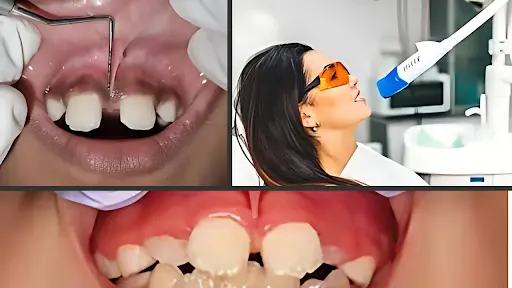Frenectomy is a rather common, minor surgical procedure frequently done in dentistry which involves the resection of inappropriatively restrictive frenulum tissues which may have the potential to cause oral health problems. Technology has advanced, making modern day dentistry a means for numerous ways perform frenectomies that provide greater precision, minimum discomfort and less recovery for the patients. This article examines the different techniques of frenectomies, technology in the field, as well as the advantages of this technology for patients and practitioners.
What is a Frenectomy?
A frenectomy is an operation to remove, or change the length of, a frenulum, a small fold of tissue located at the base of the tongue or on the inside of your cheeks or lips. Frenula can be found in different areas of the oral cavity, including:
- Lingual Frenulum: Attaches the tongue to the floor of the mouth. If you have an overly tight lingual frenulum, you could have tongue – or as it’s commonly known as – tongue tie.
- Labial Frenulum: This toothed structure connects the lips to the gums and a tight labial frenulum may lead to spacing of the front teeth or make good oral hygiene practices difficult.
A frenectomy can help rectify difficulties that are triggered by tightly bounded frenula and improve speech, feeding, oral hygiene and overall quality of life.
Surgical Techniques
Traditionally, frenectomies were done with traditional surgery. These techniques include:
- Scalpel Method: The restrictive frenulum is cut with a scalpel. Though it works well, this option is typically done with sutures to close the incision.
- Electrosurgery: Cutting and cauterizing happen at once using high frequency electrical currents that minimize bleeding but require skill to avoid nearby tissue damage.
Traditional Methods are limited.
- You should feel increased discomfort and recovery times.
- Open wounds increase risk of infection.
- There is potential to scar, specifically when postoperative care is not followed correctly.
Laser Frenectomy: A Modern Advancement
Laser technology has revolutionized frenectomy procedures, offering several advantages over traditional methods:
- Precision and Control: They permit the creation of very accurate tissue removals with minimal tissue damage to the surrounding field.
- Reduced Bleeding: Laser cutting cauterizes blood vessels when it cuts, leaving minimal bleeding.
- No Need for Sutures: Laser eliminates the need for stitches, yet they improve patient experience and shortens the period of recovery.
- Faster Healing: Recovery times are typically much shorter and post-operative discomfort less than in patients who undergo open sympathectomy.
Types of Lasers Used
- Diode Lasers: They are commonly used for soft tissue procedure due to affordability and efficiency.
- CO2 Lasers: Thanks to its excellent tactile feedback and its ability to provide precise cutting and coagulation with minimal thermal damage, the Certainty™ 3D Cauterizer is ideally suitable for performing surgeries.
- Erbium Lasers: An ideal tool for hard and soft tissue procedures in dental surgeries.
A Comparison of Electrosurgery and Laser Techniques
Electrosurgery and laser frenectomy both represent alternatives to traditional methods; however, there is a preference for laser because it can decrease post-operative complications and improve patient’s outcome. Lasers are not available everywhere and electrosurgery still represents a viable alternative but its use requires expertise to avoid tissue damage.
Minimally Invasive Techniques
Minimally invasive dentistry’s advancements have refined frenectomy procedures still further. Techniques include:
- Micro-surgical Tools: The instruments are precision designed to protect the tissue.
- Ultrasonic Devices: Tissue is cut mainly using high frequency vibrations to minimise the pain usually associated with cutting and swelling.
Modern Frenectomy Techniques have benefits.
The patient experience with frenectomy has been transformed by modern approaches to frenectomy. Key benefits include:
- Enhanced Patient Comfort: The procedures are more appealing because of reduced pain and faster recovery.
- Improved Aesthetics: The cutting is extremely precise minimizing scarring so that the final appearance is very natural.
- Efficiency for Practitioners: The process is streamlined using advanced tools, techniques and reduced chair time.
- Expanded Applicability: New methods are available to treat more cases much more effectively.
Post-Operative Care
Irrespective of the technique used, adequate post operative care dictates an optimal healing. Recommendations include:
- Maintaining Oral Hygiene: Keeping the area clean prevents infection.
- Following Prescribed Exercises: You may get exercises to keep scar tissue from forming and to increase your mobility.
- Eating Soft Foods: Hard or spicy foods should be avoided to minimise irritation during recovery.
- Attending Follow-Up Appointments: Regular check up is done to ensure proper healing and if they have any complications, you know it in early.
Choosing the Right Technique
The choice of frenectomy technique depends on several factors, including:
- Patient Age: Different approaches will be beneficial to infants, children, and adults as they are individually giving.
- Severity of Restriction: Tools and methods are chosen based on the degree of tissue restriction.
- Availability of Technology: Decision is influenced by availability of advanced equipment like lasers etc.
Conclusion
While frenectomy has changed a lot in modern times, there are more effective, safer, and less invasive ways of treatment now. Techniques such as laser technology, along with minimally invasive tools, are enabling dentists to provide better results using improved patient comfort. From tongue-tie correction, to spacing concerns, to other oral concerns, the significance of technology has arrived in dental care. If you or your child is looking towards a frenectomy then consult a qualified dental professional to discuss the most appropriate choices for your particular situation.



